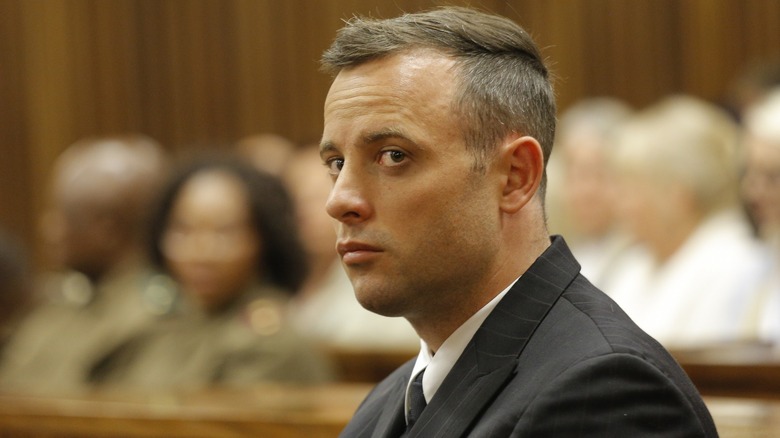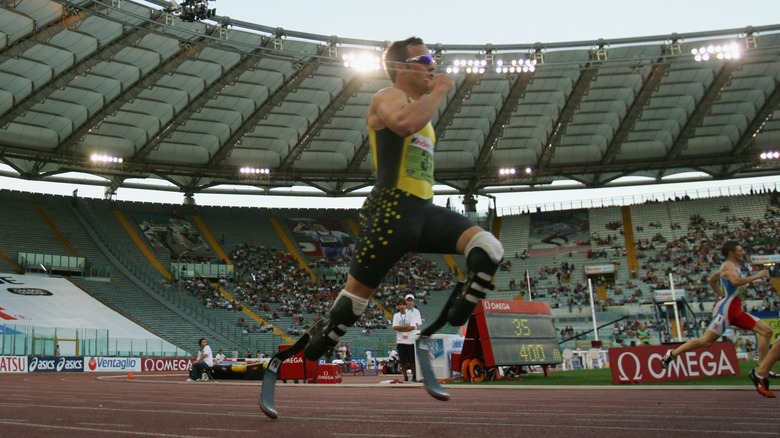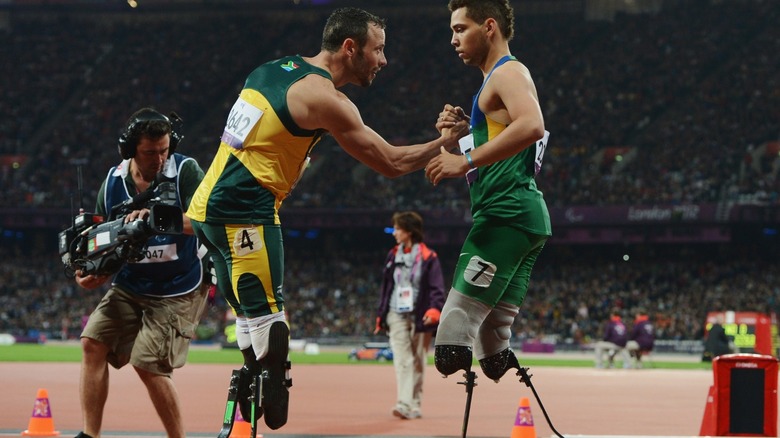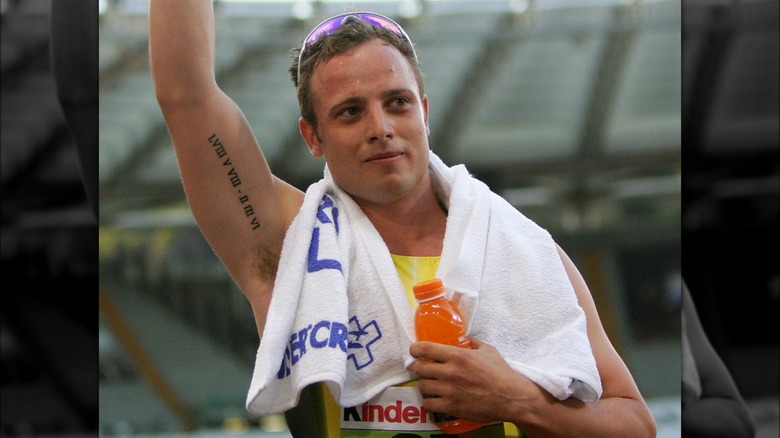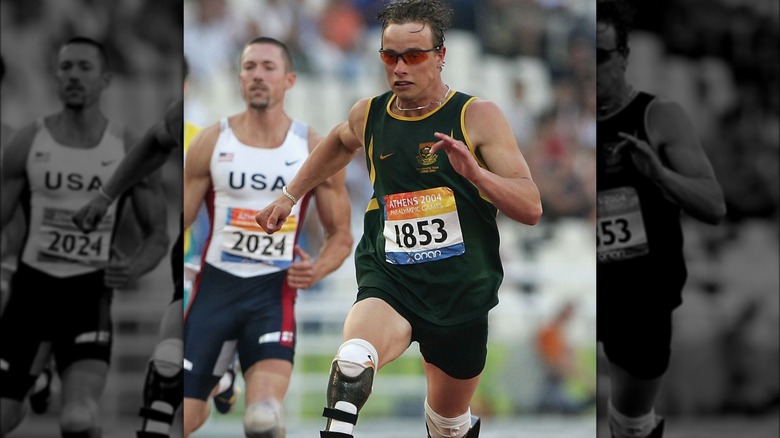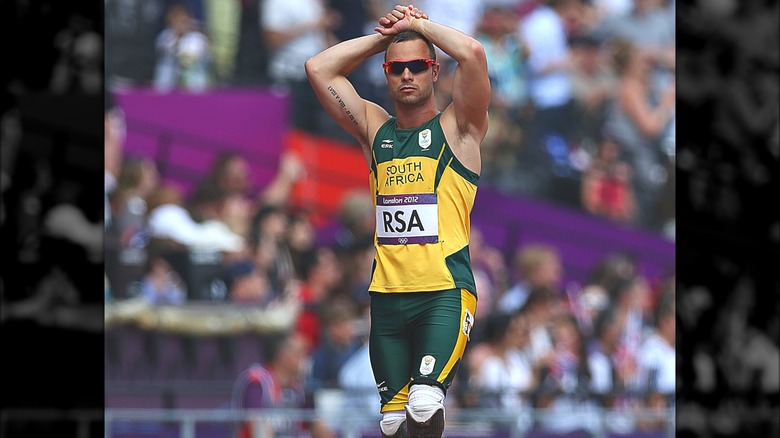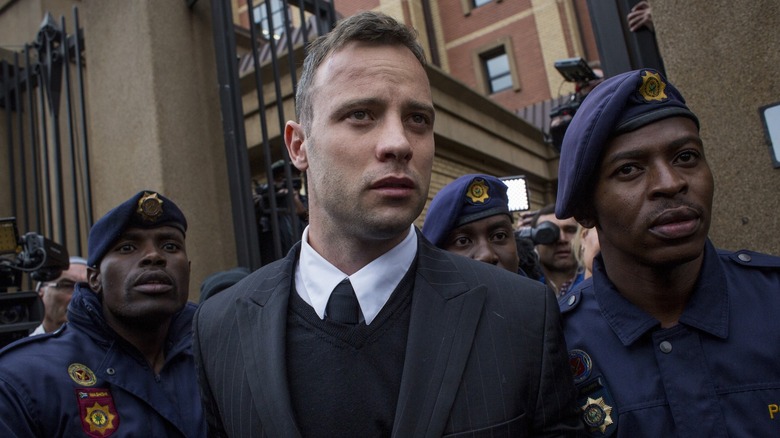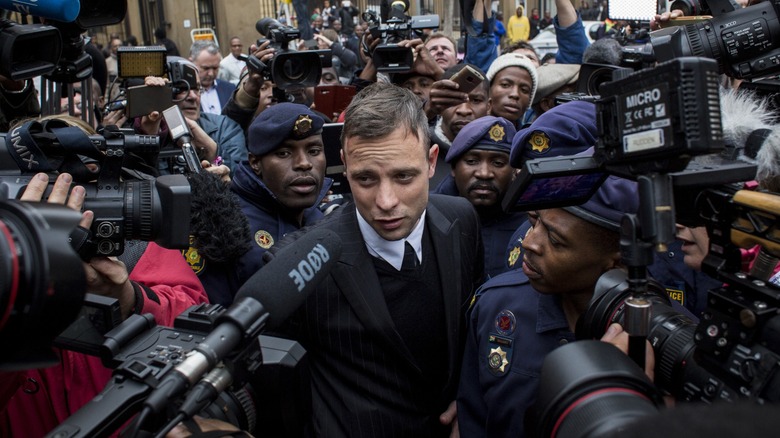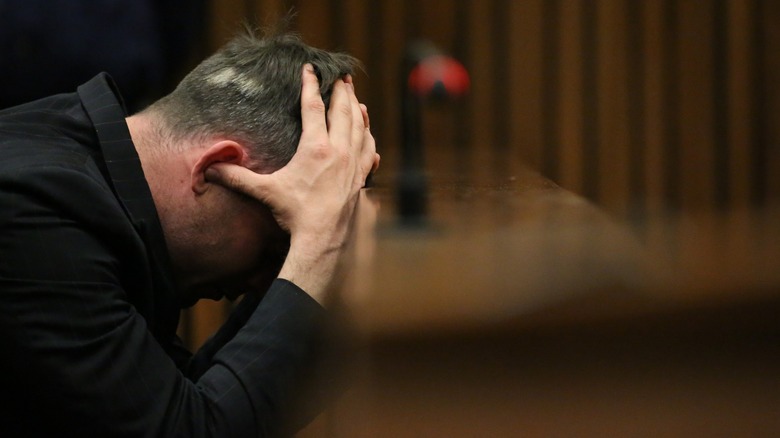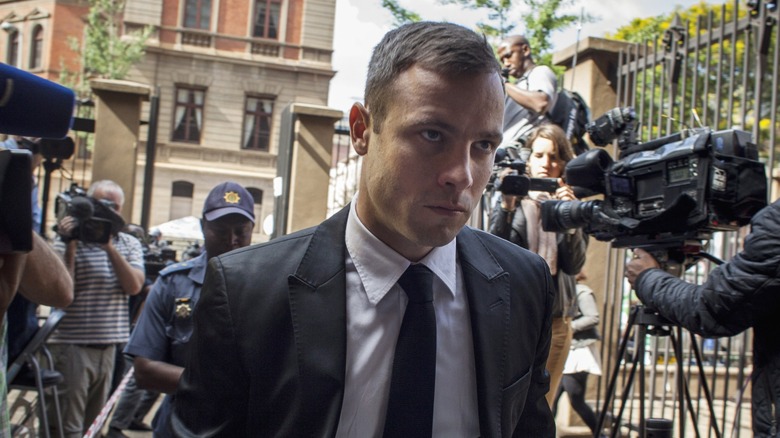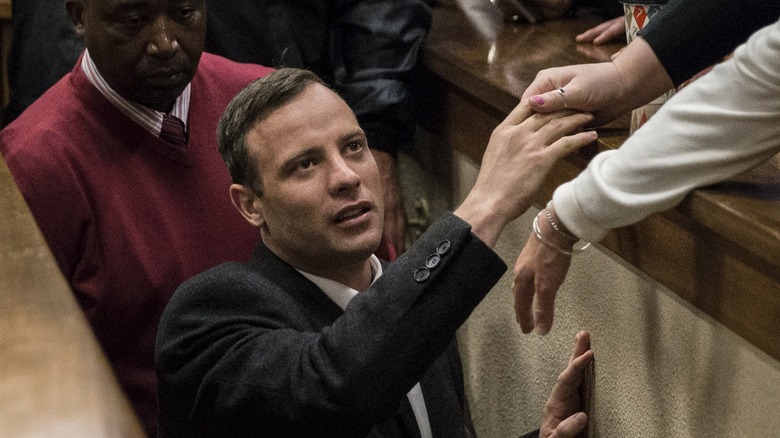The Untold Truth Of Oscar Pistorius
For many years, Oscar Pistorius had one of the most inspiring stories in modern sports. Born in 1986 in Johannesburg, South Africa, he was missing bones in both his legs and feet. Nevertheless, Pistorius grew up and became a world-famous sprinter, even winning numerous gold medals at the Paralympic games. Due to his condition, when he was less than a year old a team of doctors amputated his legs below his knees, requiring him to use prosthetics to run, which later earned him the nickname "blade runner."
Pistorius later competed in the 2004, 2008, and 2012 Paralympic games, earning a gold medal in 2004, three gold medals in 2008, and another two gold medals and a silver in 2012. He also ran — but did not gain a medal — in the 2012 Olympics, becoming the first amputee to compete in the games. However, Pistorius' life and future abruptly changed on Valentine's Day February 14, 2013, when he shot his girlfriend Reeva Steenkamp in his Pretorian home. A court later found Pistorius guilty of murder and sentenced him to more than a decade in prison.
Yet, for all of his fame and publicity, there is still a lot that most people do not know about him. From his run-ins with law enforcement to his early experiences with his prosthetics as a boy to even his humanitarian projects, Pistorius is a perplexing man to say the least.
Pistorius' surgeries allowed him to run later in life
On November 22, 1986, Oscar Pistorius was born with a rare condition known as bilateral fibular hemimelia, which means that both of the fibulas in his legs were missing, and both of his feet were deformed, with only two toes each. Fibular hemimelia is a relatively unknown disease — scientists are not entirely clear on what causes it, and Pistorius' condition of bilateral (both legs) fibular hemimelia is exceedingly rare.
As Pistorius explains in his autobiography "Blade Runner," it was actually his father who realized the physical deformities before the doctors did, and his parents were very proactive in finding a solution that would allow their son as much mobility as possible later in life. Some doctors wanted to amputate Pistorius' legs above the knee, which would have meant significantly less maneuverability without his knee joint. Instead, they talked with nearly a dozen different doctors and finally found one who suggested below-the-knee amputation and prosthetics.
Pistorius had the surgery when he was less than a year old, and he got his first prosthetics when he was about a year and a half old. The below-the-knee surgery allowed Pistorius the chance to later pursue athletics like sprinting, which he crucially needs his knee joint to help with. It's thanks to his parents' foresight that he was able to compete in sports and eventually become a champion.
He realized his prosthetics were advantageous early on
While it was Oscar Pistorius' sleek looking carbon fiber prosthetics that earned him the "Blade Runner" moniker from fans as an adult, his first sets of prosthetics when he was young were much more primitive. According to his autobiography "Blade Runner," he used to constantly go through sets of prosthetics as they rarely lasted more than a month or two, and their material was a surprisingly heavy mixture of plastic and glass fiber.
Sadly, his artificial legs sometimes made him stand out from his peers. On at least one occasion when he was just a young boy, another acquaintance broke his prosthetic legs when he swung a large wooden stick at them (though it seemed to traumatize the other boy more than it did Pistorius). At around that age, Pistorius also began to realize the added utility of having artificial legs, which he learned while playing with his brother Carl in a homemade go-kart their uncle had built. They were riding the vehicle down a hill, and they had no brakes to stop them from hurtling into a wall, so Carl grabbed one of the artificial legs and jammed it into the ground.
The idea worked: The go-kart came to a stop before crashing, and the boys escaped what could have been serious injuries. The incident was one of many that taught Pistorius the sometimes unconventional advantages of his unique legs — something he would always remember.
His mother died when he was 15
Despite his birth defects, Oscar Pistorius had a relatively happy childhood. He spent his summers with his family in the coastal South African town of Plettenberg Bay, and his father drove a Mercedes-Benz coupe that had a sunroof and a nice leather interior (via "Blade Runner"). Still, when he turned 7 years old his parents got divorced in what was a very sad event for the young Pistorius.
When his parents separated, Pistorius and his siblings spent most of their time at their mother's house, and they only saw their father a couple weekends a month once he moved away to another town. Nevertheless, Pistorius enjoyed his time with his father at his new house, even bringing his friends along at times. Pistorius' mother remarried in late November 2001, and just a few months later in March 2002 she died after slipping into a coma from an undisclosed viral illness. At first, the doctors treated her for hepatitis after a misdiagnosis, and Pistorius was there by her side when she passed away. He was only 15 years old.
Pistorius was upset by his mother's premature passing. Though at first he was willing to return to his boarding school, he soon realized how much her death affected him and had to take some time off school. Pistorius used sports to help cope with the emotional pain, and he got both her birth and death dates tattooed on his arm in Roman numerals.
He set a world record in his first race
It probably sounds a bit odd considering his later success, but when he was growing up Oscar Pistorius hated running and doing other athletics. In contrast to the contactless sport of sprinting that he would later excel in, his first love was actually wrestling (via "Blade Runner"). Later, when he got into high school, he moved on to playing water polo and rugby.
Rugby became a passion for Pistorius, but a serious injury in the summer of 2003 put a damper on his career. In January 2004, as part of his physical therapy, he began running sprints. While he had previously loathed athletics, his newer prosthetics were much lighter than before, making it easier and more enjoyable for him to run. He ran his first race less than a month after starting to train, and, incredibly, he set a new world record in the 100-meter race. What's more, less than a month later he broke his own world record with an even better time.
Soon, he left rugby behind and competed in the South African Disabled Games, which ended up being his first experience competing alongside other disabled athletes. A few months later, Pistorius began training for the Paralympics after being selected by South Africa as a representative, and he earned his first gold at Athens in 2004 (pictured above) — an improbable nine months after first starting training.
He was arrested at an airport in 2006 over his prosthetics
In August 2006, Oscar Pistorius was at the Johannesburg International Airport preparing to fly to Holland when he ran into a big problem. At the airport, he was in a special room while a security officer was checking out his prosthetics since they normally set off the metal detectors (via "Blade Runner"). Yet when the officer started to use an explosive-sensing device on Pistorius' artificial limbs, they tested positive, and he was in a world of trouble. The officers placed him under arrest and started shouting at him, and he was very frightened by the experience.
Finally, after an intense 20 minutes, the officers revealed the problem to Pistorius, who at first was in shock about what they were saying. As it would later turn out, the explosive-sensing device detected gunpowder on his prosthetics and not an actual bomb. Pistorius had likely picked up the residue when he visited a shooting range with one of his friends days before he was scheduled to fly out. Some of it must have rubbed on his artificial legs while at the range — possibly from his own hands touching them — and later triggered the security device at the airport. Pistorius ended up missing his original flight, and it took them about two hours to fix their mistake, but he was eventually able to fly out and was cleared of any criminal wrongdoing.
He was involved in humanitarian projects in South Africa
Once achieving fame and fortune as a world-class runner, Oscar Pistorius made the conscious decision to give back and help other less fortunate amputees. In "Blade Runner," Pistorius wrote that "my main goal in life, alongside my sporting goals, is to help others." He became an ambassador for the non-governmental organization Mineseeker Foundation and its Sole of Africa campaign, which finds and removes landmines and other unexploded ordinances from areas in Mozambique.
There is always the danger of innocent people being killed or maimed by unknowingly walking on unexploded landmines or other ordinances. It's also very dangerous to try and remove them as they can inadvertently go off. By removing the explosives, Mineseeker saves countless lives and prevents untold amounts of injuries. Pistorius chose to help in Mozambique in part because it shares a border with South Africa — and because of the nature of the people he was to help. In his book, he said he felt a deep connection with them over their shared amputee status, which inspired him and strengthened their bond.
In addition to his work with Mineseeker, Pistorius also worked with the Chaeli Campaign, another charitable organization in Africa that helps the disabled and paralyzed. His ultimate goal was to start a mobile prosthetics project to bring prosthetics to people throughout Africa, though the fate of that project is unclear.
He had a history with guns prior to the murder
Well before the events that resulted in Oscar Pistorius fatally shooting Reeva Steenkamp, he had a curious history with firearms, both publicly and privately. As an adolescent, Pistorius' high school had a shooting range, and he was known to continue to frequent private ranges as an adult. In 2011, he even tweeted about his shooting prowess, writing, "Had a 96% headshot over 300m from 50shots! Bam!" The next year he participated in a Nike advertisement captioned, "I am a bullet in the chamber."
In an article in The New York Times, Pistorius mentioned that he went to the range occasionally when he was having difficulty sleeping. He also showed that he was pretty well versed with his gun, even instructing the article's author about proper shooting techniques. His ex-girlfriend testified in court about an incident in September 2012, where he discharged his firearm out of his car's sunroof after a confrontation with a police officer. Furthermore, in January 2013, just a month before Steenkamp's death, Pistorius was at a restaurant handling one of his friend's firearms when he accidentally fired it under the table. He had a friend take the rap.
When Pistorius faced trial over Steenkamp's death, the court also hit him with violating South African gun laws over both the 2012 and 2013 shootings. While the incidents might have been laughed off at the time, following his murder conviction they appear in a very different light.
Pistorius got sick while listening to testimony
Oscar Pistorius' murder trial was incredibly harrowing for all parties involved, to say the least. At least twice during the trial, Pistorius became so overcome with emotion that he actually vomited. Both times it happened as he was either hearing about or looking at graphic photos of the night Reeva Steenkamp died.
The first time was early in the trial when the professor who had conducted the postmortem autopsy testified about Steenkamp's body. As he was detailing the gunshot wounds and other injuries to her body, Pistorius started to become audibly sick. The prosecutor had to ask for a brief recess as he cried and struggled to compose himself. His brother and sister were able to calm him down, and after a short delay the trial resumed.
The second time Pistorius threw up during the trial was after a police officer inadvertently displayed a photo of Steenkamp's dead body while Pistorius was testifying. The officer was flipping through multiple photos to get to one of the bathroom when the photo of Steenkamp came up onscreen for a few moments. Not only did it cause Pistorius to get sick again, but it also shocked Steenkamp's family in attendance, too. Pistorius was able to continue testifying again afterward, but it was an especially poignant moment in a trial already full of them.
Pistorius was resentenced several times
Oscar Pistorius' trial for the murder of his girlfriend Reeva Steenkamp came to a close on September 12, 2014, but it would be several years before the final sentencing verdict came down. Initially, a judge found Pistorius not guilty of murder but guilty of culpable homicide, which is the rough equivalent of manslaughter in the U.S. judicial system. The judge later gave Pistorius five years in prison, and he got out in October 2015 on house arrest after serving roughly a year inside, The New York Times reported.
However, the prosecutors appealed the conviction of culpable homicide and instead pushed for it to be upgraded to murder. In December 2015, the appeals court agreed and changed his conviction from culpable homicide to murder, saying that the original judge had misapplied the laws and wrongly ruled on evidence in the original trial. Pistorius was allowed to remain out on bail following the new conviction — until July 2016, when the original judge in the case sentenced him to six years in prison. Yet prosecutors appealed the judge's decision again, this time taking issue with the six-year prison sentence instead of the 15 they wanted. As reported by The New York Times, the court initially denied their appeal in August.
Nonetheless, the prosecutor's appeal continued, and in November 2017 South Africa's Supreme Court gave Pistorius 15 years in prison with credit for time served, per The New York Times. Pistorius had murdered Steenkamp all the way back in February 2013, and it took more than four years to finally resolve the trial.
He was in a prison fight
Oscar Pistorius first received a sentence of five years in prison after his initial conviction of culpable homicide in 2014, but he only served about a year before being released to house arrest. He found himself in prison once again in 2016 following his new conviction for murder, and he stayed behind bars until early 2024. During his second incarceration, Pistorius served his time at the Atteridgeville Correctional Center due to its ability to care for disabled prisoners.
Even so, Pistorius was at Atteridgeville when The New York Times reported he got into a fight with a fellow inmate in December 2017, just a month after having his sentence increased from six to 15 years. Details about the assault were relatively sparse but did include that Pistorius was bruised over the incident and that it involved him using the phone. Prison officials did not seem to realize there was a fight until they found bruising on Pistorius during a medical checkup, but he was not seriously injured.
The brawl allegedly started when Pistorius was taking up too much time on the phone, which upset some of the other inmates — at least one of whom was angry enough to violently lash out. Authorities were not sure who started the fight, though they mentioned if it was Pistorius he would likely lose privileges. Besides the brawl, his time in prison seemed relatively uneventful.
A math error caused him to stay in prison longer
In March 2023, Oscar Pistorius dominated the news cycle again for the first time since his 15-year sentence for murder in November 2017. This time, the news broke that Pistorius was denied parole because he had not served enough time behind bars. The family of Reeva Steenkmap were reportedly happy with the decision to keep him incarcerated, and it was thought he would have to wait more than a year until August 2024 for another shot.
However, in September 2023 his lawyers appealed the decision to deny Pistorius parole, the Los Angeles Times reported. They argued that there was a calculation error that wrongly concluded he had not been eligible in March. In July 2016, the court had sentenced Pistorius to six years in prison, which a higher court changed to 15 years in November 2017. Apparently, the parole board had started the calculations of his sentence using the November date instead of the July date, which took 16 months' worth of credit away from him.
Following the appeal, the parole board granted Pistorius parole to start in early January 2024, when he was finally released, per Rolling Stone. He is on parole until 2029 and he cannot drink, use drugs, or leave the Pretoria area without permission. His final release was met with mixed emotions and responses across the world, but as of January 2024 Pistorius was at home with his family, and he is set to be a free man in 2029.
